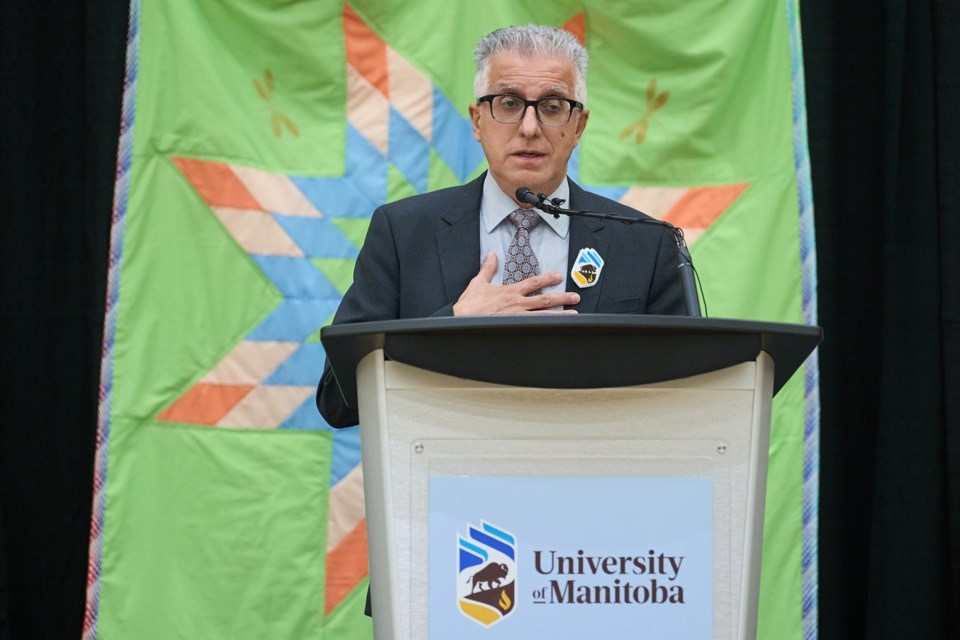WINNIPEG — The University of Manitoba has publicly apologized for harm it has caused to First Nations, Inuit and Métis communities more than a century after it began accepting and storing Indigenous remains.
The university apologized Monday, saying it inappropriately accepted and stored ancestral remains along with burial belongings and cultural artifacts without consent from Indigenous communities.
"For most of our history, this university has been in the wrong relationship with First Nations, Inuit, and Métis Peoples," university president Michael Benarroch said after sitting in a pipe ceremony with Indigenous community members.
Starting in the 1890s, Benarroch said, founding members of the university desecrated graves and mishandled remains.
"Our historical members justified their shameful and degrading behaviour in the name of science and education."
He said the university broke the basic principle of humanity — to leave those buried at peace.
"We apologize for these past wrongs," Benarroch said. "We are sorry."
"We recognize we must change, and we are changing."
The university started working to repatriate remains four years ago.
Members of the anthropology department were grappling with the university's history and proposed it do something to right its wrongs, said assistant professor Lara Rosenoff Gauvin.
The department worked with elders, grandmothers, grandfathers and knowledge keepers in late 2020 and formed a council to provide guidance on how to respectfully care for the remains while working to identify and return them to their home communities.
"A really large part of coming to terms with that history, and particularly for heritage-holding institutions, is to really confront the truth around why they have Indigenous Peoples' heritage remains to begin with, and then really starting the hard work of figuring out how to go about making them right," said Rosenoff Gauvin, who is also a council co-chair.
The earliest documentation of ancestral remains at the university is from the early 1900s, said Rosenoff Gauvin. They were taken to what was then Manitoba Medical College.
In the following years, the university acquired remains and artifacts in various ways. In the 1940s, one person recovered remains from farms. Decades later, more were discovered during the construction of the Red River Floodway.
A large portion of items were recovered through public works projects, including the building of the Grand Rapids Generating Station in the 1960s, said Rosenoff Gauvin.
Policy at the time dictated any discovered remains and artifacts be sent to the university. In most cases, nearby First Nations and Métis communities weren't consulted, said Rosenoff Gauvin.
The university last acquired remains in the early 1980s, after the provincial government developed a protocol requiring consultations with First Nations and Métis communities when remains are found.
Acquiring remains is not limited to the University of Manitoba. Universities, museums and galleries across Canada and around the world are wrestling with their own histories.
"It was an accepted practice, and it just illustrates the depth of racism and how Indigenous people have been objectified and seen as less than human," said Pahan Pte San Win, a Red River Métis citizen and a co-chair on the University of Manitoba's remains and artifacts council.
Some institutions have started returning ancestors back to their communities.
In 2020, the remains of Nonosabasut and Demasduit, two Beothuk ancestors stolen from gravesites in central Newfoundland in the 1800s by a Scottish merchant, were repatriated from Scotland after years of advocacy from the Miawpukek First Nation.
Other universities have also developed repatriation policies and worked with communities to return remains.
Rosenoff Gauvin said Indigenous communities have control of their repatriations, and there is no cost to them. The university reaches out to identified communities, so the burden isn't on them to do their own research.
"This is our mandate. It's the mandate to return and to atone," said Rosenoff Gauvin.
She would not disclose how many remains and artifacts the university has.
For Pte San Win, witnessing atrocities Indigenous Peoples have endured has made her feel pain and anger, but she says hearing an apology and commitment from the university leaves her with hope.
"I need that and our community needs that to be able to believe that change is possible."
This report by The Canadian Press was first published June 3, 2024.
Brittany Hobson, The Canadian Press



